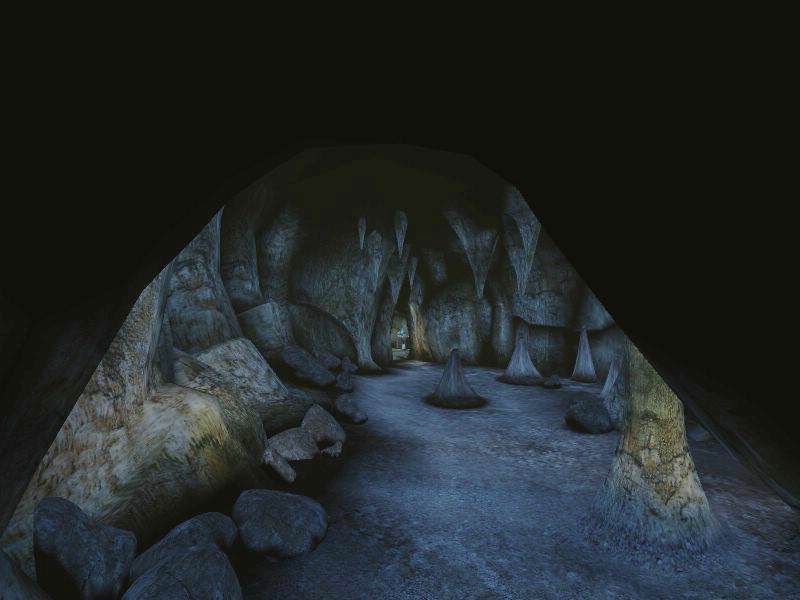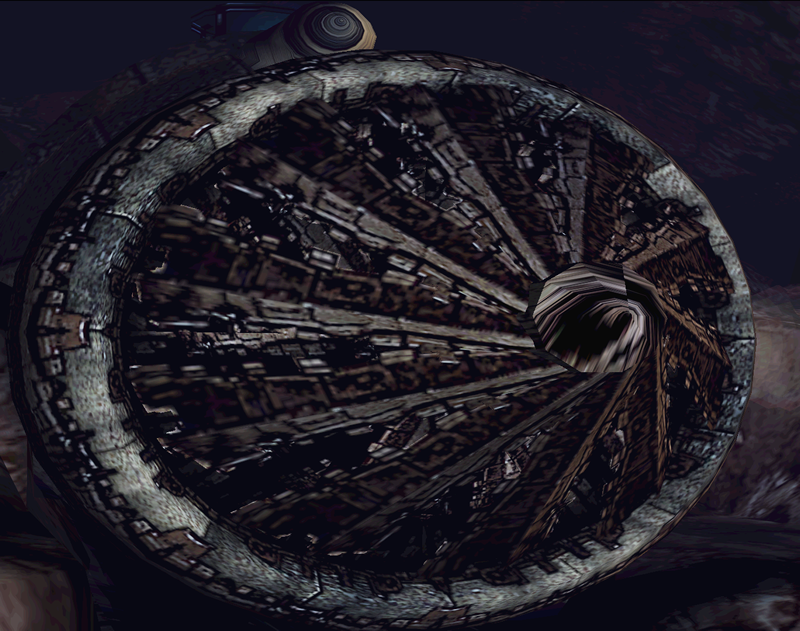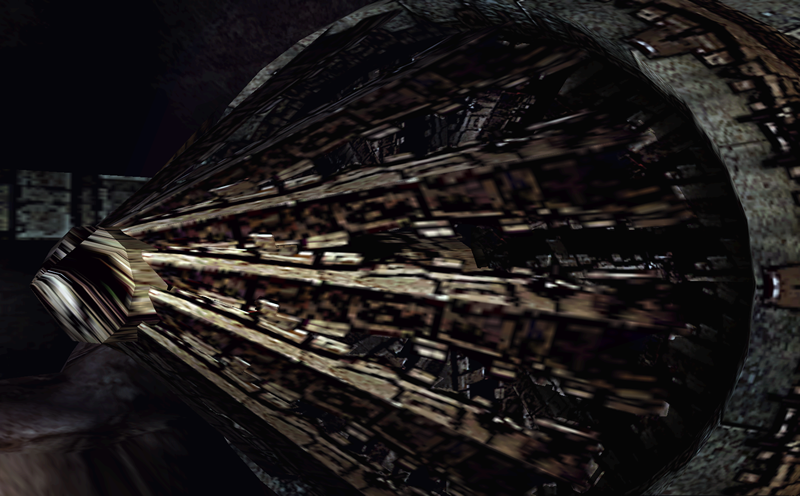

|
|
The cavern system can be reached from the surface through various means — a number of ventilation shafts were constructed in the early days of D'ni — but the primary and most spectacular route is via the Great Shaft. The Shaft was part of a project that the D'ni invested a great deal of time, money and effort on, only to abandon it within yards of breaking through to the surface. There are two ways into the Shaft. Anna found a cave that accidentally opened into a corridor of the Shaft complex. Apparently the D'ni had gotten very close to it and time and mother nature did the rest, although what was exposed was a sealing compound that blocked off immediate access. Another is located in the cinder cone of the volcano on the Zandi property. Atrus, as a boy, had tried to create a steam powered electric generator atop a vent in the cinder cone. He miscalculated the pressure tolerances, and back pressure built up until it exploded, creating a hole into a small cave that one of the Shaft complex corridors had cut through. The explosion also blew a hole through the corridor wall. According to Guild Surveyor Aitrus' map of the tunnel system, the exit tunnel from the Shaft would have exited on the volcano's slope, not far from the Cleft. The original plans for the journey to the surface called for a continuous tunnel at a gentle angle to be constructed until it reached a breakthrough point that had not yet been calculated. They were taking it one step at a time, sounding the rock to make sure they tunneled through the most stable formations. However, the D'ni council became impatient and decided in the end to tunnel directly upward from where the tunnel was at that time. This was a fateful decision, since arbitrarily diverting the route upward ignored the safety protocols the Guild of Surveyors had been carefully following. As it turned out, the shaft passed through several layers of geologically unstable materials, which they tried to compensate for by lining it in nara, their densest and strongest building material. That proved to be insufficient when an earthquake broke a section of the nara free from the wall while the shaft was undergoing its dedication ceremonies, killing a number of the upper class people attending and injuring many more. The original path, as it eased toward the surface and turned to avoid unstable rock, stretched somewhere between 60 to 90 miles from the D'ni cavern to the Great Shaft. Surveyor guildsman Ātrus described it as a three-day journey on foot. The project to create a tunnel to the surface had been controversial, and there were several times during its construction that the council was tempted to cancel it. Many of the D'ni believed that they should never visit the surface world, that it was not what Ri'neref intended. Indeed, officially no D'ni ever went to the surface, although several workers assigned to dig the first ventilation shafts for the cavern disappeared and were never seen again. There are some who speculate that they became the ancestors of the Amad people whom Gehn met after he left the Cleft when he turned fourteen, although there is no hard evidence to support the idea. In the end, the council decided that they'd gone too far not to complete the project. However, instead of continuing the slow, laborious process of digging a normal tunnel the rest of the way, they chose to short-cut the process by digging straight up for the remaining distance. Thus was born the Great Shaft, or Regaro Tiwa in D'ni (regaro tiwa). The Shaft is a three mile deep cylinder lined with nara, the extremely dense fabricated stone used in D'ni construction. It is fed air by eighty ventilation fans, and twenty thousand firemarble lamps were originally used to light it. There are four rest houses (eder tomantē, eder tomantE ) spaced along the Shaft, which contain sleeping niches and KI terminals. Yeesha placed linking books to a garden Age called Direbo in them when she was seeking the Bahro tablet. The Shaft was designed by Guild Masters Garten and Geran of the Guild of Surveyors, along with a support team from the Guild of Cartographers. Work began in 9338 DE (AD 1682). All four of the great boring machines of the D'ni Empire (Grinder, Burrower, Rock Biter, and Stone Tooth) were diverted to excavate it. That was a major decision, since the great machines were usually booked years in advance for any project, and they had to be torn down into many sections to fit through the D'ni tunnels. The Great Shaft has seen some fairly significant, if unintended, traffic in its time. It was the route by which Anna, Gehn, Atrus, and much later, the DRC traveled between D’ni and the surface. The symbol of the Great Shaft is a monogram of the D'ni word "tiwa", which means "shaft" in the sense of a mineshaft. Separated from each other and then written in standard D'ni left-to-right order, the letters look like this:
There are other D'ni monograms in the shaft. The first is another monogram that is set above a number of lava doors in the bottom of the shaft. The letters are repax (repats), which means "the city", and they mark the path toward the D'ni Caverns.
In sections of the Shaft complex that are normally inaccessible, other monograms can be found. In a blocked off corridor, there is one that has not been positively translated yet, but might say retalEo (retalēo), which means "the surface".
Another monogram found in normally inaccessible parts of the Shaft complex reads tiwa (tiwa), which as mentioned before means "shaft". They mark the pathway to the Shaft itself.
An example of plain D'ni writing can be found on the screw pillars that raise and lower the center platform in the floor of the Shaft. It consists of the same words repeated continuously upside down in spirals up the pillars. The letters are retalEo (retalēo), which means "the surface".
This is a DRC map of the top of the Shaft complex, showing the entrance from the caldera, the natural cave between Atrus' hole and the exit corridor, the highest of the four eder tomahntee, the room at the top of the main ventilation shaft, and the walkway around the top of the Shaft. To the right is an illustration of one of the two elevators. This map differs from the map drawn by Aitrus, which shows the Shaft farther away from the volcano and shows no sign of the ventilator, eder tomahntee, or the other features. I have never come across a reason for the discrepancy, other than the chance that Aitrus' map is highly inaccurate.
This unassuming hole in the volcano's caldera is the entrance to the Great Shaft complex:
Climbing down a rope latter from the cinder cone places you in a natural cave:
The end of the cave opens into a corridor that was intended to be the exit to the surface. It leads from the top of the main ventilation shaft room to the highest of the eder tomahntee. There was no opening into the caldera or the cave originally. If it had been completed, the corridor would have exited on the side of the volcano somewhere near the wahrk skeleton, although that's a guess based on Aitrus' map of the cave system. This sign is on the corridor wall, which might say "pb teb 515". Alternately, since the numbers are spaced and the four parts can be thought of as columns, it could be "pb teb 20 15" or "pb 20, teb 15". In any case, I have not heard a reasonable idea regarding what it is supposed to mean.
As one walks toward the top of the Great Shaft, one can hear and occasionally see bats. I could never get a good picture of one, but Mexican Free-tailed Bats are common in the region.
An under-rated part of the Shaft complex is the main ventilator shaft that runs next to it all the way to the bottom. It's not often mentioned, even though it is an equally impressive accomplishment. Here is the top of it, which must be passed to get to the Shaft itself:
This corridor connects the ventilator and the Great Shaft:
This is a view down the Shaft from its highest point:
When enough of the internal bracing was added, two elevators were added to make ascending the Shaft quicker and easier:
The bottom of the Great Shaft is elaborately decorated, and has a platform that raises and lowers on four giant screws:
The platform from below: There's a maintenance access pit below the platform:
View of the platform from a walkway:
Vehicles The Great Shaft is home to the remains of two D'ni vehicles, although the DRC apparently cleaned up the remains of one and the other is in a place that is inaccessible normally. When Anna first broke into the Shaft complex, she found the remains of a D'ni digging machine. Documentation from the time of DRF exploration calls it the Worm. Surrounding the Worm is a reddish sealing material. Anna and her father discovered that material blocking the cave that they found and Anna eventually broke through it to find the D'ni tunnels. The Worm is still operational, although it's trapped in fallen rock and the sealing material the D'ni used to block entry into the tunnels. Here is a picture of it with the cutting blades spinning.
The machine is powered by a sphere that looks like a firemarble, although it's much more potent. It apparently gives off more electricity than light. This port on the side of the digger is where the sphere is located.
Standing alongside the digging machine. When it's shut down, the blades fold up like an umbrella to form a cone. The port for the power sphere is easily seen on the side.
A view of the front of the machine. There's an auger at the end of the drive shaft, and the cutting blades are set in a slight spiral pattern on the shaft. the blades turn clockwise when operating.
A side view of the cutting blades. The teeth are set facing outward so they come into contact with whatever rock or dirt the machine would be attacking. The blades themselves would not. This picture is not a very well resolved, so it's difficult to see how many teeth are mounted on each blade. They woud be removable for replacement or sharpening as needed.
In this picture, I've opened the access port and the power sphere has been extended out on a set of rails.
Once disconnected, the power sphere stops glowing so brightly. It's being held in my right hand, and is roughly the same size as a firemarble. Something notable in the following picture is that the Worm traveled along the recessed track in the corridors, and you can see that it is nestled into the track below the sealing material. You can see that I'm standing on a solidified pool of it.
The other vehicle that once was found in the Shaft complex is a mine car that is called a Scarab in documentation. Unfortunately, it was wrecked soon after its discovery.
Explorer Tweek found a model of it and was gracious enough to donate these photographs so that you can see what the Scarab looked like before the accident. Tweek hadn't finished painting the model before taking the photographs, so it's not quite right yet.
The Scarab also traveled in the recessed tracks recessed into the corridors of the Shaft complex. The forward wheels gripped the sides of the channel to guide and propel it. In the nodes where corridors came together, there were curbs that could be raised up from the floor in concentric rings for the same purpose. Descent: A minor controversy that is still debated is the nature of the second version of the Great Shaft, which is often called Descent. There is a Bahro stone at the broken end of Tokotah alley that is sometimes there, and sometimes not. It links to an instance of the Great Shaft where Dr. Watson seems to have hidden for a time to sort out his thoughts, and which seems to have resulted in him deciding to try Yeesha's quests for himself. This lead to him discovering the Bahro tablet, and resulted in the Bahro becoming free for the first time in many thousands of years.
That version of the Shaft has little light and no support struts. It also looks like it's in much worse condition than the one accessed through the volcano. If one can climb down to the bottom, there are significant differences in details from the regular one as well. The area at the bottom seems incomplete and many parts are two-dimensional, and the decorations are rough approximations of those found in the real Shaft. My own theory is that the Bahro created it specifically as a place for Dr. Watson to hide. This theory is supported by the fact that it is only accessible by means of a Bahro stone. The main feature of Descent is an eder tomahn found midway up the Shaft. I found the shaft too damaged and dark to climb up to the top to see if there were any signs of the upper level of the complex. Others have proposed ideas as to what and why it exists, one of which is that it is a real version of the shaft that was displaced in time. That's not unreasonable, since we now know that the Bahro have an ability to control the passage of time. My disagreement with the idea is based on the fact that there are structural and decorative discrepancies, when we know that the Shaft was never worked on again after it was completed. The job only took a few months from its beginning to the time the project was abandoned, according to Anna's journals, so there would have been no changes to the way it was originally built. Still, there is much room for speculation, and any idea about it is as likely as any other. |
Myst, the Myst logo, and all games and books in the Myst series are registered trademarks and copyrights of Cyan Worlds, Inc. Myst Online: Uru Live is the sole property of Cyan Worlds Inc. The concepts, settings, characters, art, and situations of the Myst series of games and books are copyright Cyan Worlds, Inc. with all rights reserved. I make no claims to any such rights or to the intellectual properties of Cyan Worlds; nor do I intend to profit financially from their work. This web site is a fan work, and is meant solely for the amusement of myself and other fans of the Myst series of games and books. |

 =
=  =
= 

























